Topic 5-On The Wild Side
1/92
There's no tags or description
Looks like no tags are added yet.
Name | Mastery | Learn | Test | Matching | Spaced |
|---|
No study sessions yet.
93 Terms
Define Ecosystem
All the organisms living in a particular area and all the non-living factors.
Define Habitat
The place where and organism lives.
Define Population
All organisms of one species in a habitat.
Define Community
All of the organisms of different species that live in the same habitat and interact with each other.
Give examples of abiotic factors
Amount of light, water or space available, temperature or PH of soil.
What happens to species when abiotic conditions are ideal?
Organisms can grow fast and reproduce successfully.
Give examples of biotic factors
Interspecific competition, Infraspecific competition, Predation.
Describe how Interspecific competition affect population size
When organisms of different species compete with each other for the same resources.
Interspecific competition reduces resources available for both species. Meaning both populations are limited by a lower amount of food.
They’ll have less energy for growth and reproduction, so the populations will be lower for both species.
Describe how Infraspecific Competition affects population size
Population size increases when resources are plentiful.
As population increases there’s more organisms competing for the same amount of space and food.
Resources eventually become limiting, so the population declines.
Smaller populations mean less competition- which is better for growth and reproduction so population size increases.
What does carrying capacity mean?
Maximum stable population size of species that an ecosystem can support.
Describe how Predation affects population size
As prey population increases there’s more food for predators, so predator population grows.
As predator population increases, more prey are eaten so their population drops.
Meaning there’s less food for predators, so their population decreases.
Define Predation
Where an organism kills and eats another organism.
Organisms can only exist…
Where the abiotic factors they can survive in exist.
Define niche
Role of a species within its habitat.
Eg.what they eat, they oxygen they breathe in.
How many species occupy a niche?
1
What will happen when there’s two species occupying the same niche?
They’ll compete.so, there will be fewer individuals of both species in the same area.
How can distribution be explained by the niche concept?
Organisms can only exist in habitats where all the conditions that make up their role exist.
Define succession
The process by which an ecosystem changes over time. The biotic conditions change as the abiotic conditions change.
Define primary succession
Happens on land that’s been newly formed or exposed. There’s no solid or organic material.
Define secondary succession
Happens on land that’s been cleared of all plants, but where soil remains.
Describe primary succession
Pioneer species colonise the new land surface.
Abiotic conditions are harsh, so soil to retain water.
Pioneer species are adapted to these conditions.
Pioneer species change the abiotic conditions, so new organisms with different adaptations can move in a grow.
Pioneer species die and decompose, adding more organic material making the soil deeper and richer in minerals.
Larger plants like shrubs grow in deeper soil which retains more water.
Some new species change the environment so it becomes less suitable for the previous species.
Describe secondary succession
Succession starts at a later stage because there’s already a soil layer.
At each stage, different plants and animals that are better adapted for the improved conditions move in, outcompete the plants and animals that are there and become the dominant species in the ecosystem.
The ecosystem becomes more complex , new species move in alongside existing species so biodiversity increases.
Final stage is called climax community, the ecosystem is supporting the most complex community of plants and animals it can.
What do the species that make up the climax community depend on?
The climate in the ecosystem.
How can succession be prevented?
Human activity-when a succession is stopped artificially the climax community is called plagioclimax.
Define Phosphorylation
Adding phosphate to a molecule
Define photophosphorylation
Adding phosphate to a molecule using light
Define photolysis
Splitting of a molecule using light energy.
Define hydrolysis
Splitting of a molecule using water.
What is photosynthesis?
The process where energy from light is used to break apart the strong bonds in water molecules.
What is the equation for photosynthesis?
6CO2+6H2O+light energy→C6H12O6+6O2
How do plants release energy?
By respiration.
How do animals obtain glucose?
By eating plants , then respire the glucose to release energy.
When glucose is broken down what is it used to make?
ATP
How is ATP synthesised?
By the phosphorylation of ADP using energy from an energy releasing reaction.
The energy is stored as chemical energy in the phosphate bond .
The enzyme ATP synthase catalyses this reaction.
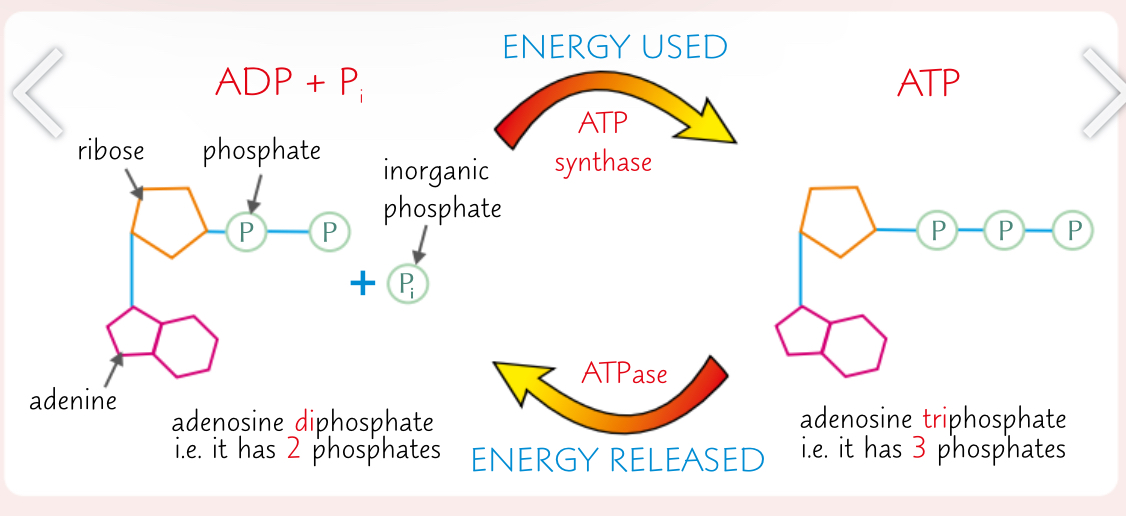
Describe how ATP changes when it arrives to where it is needed
It’s broken down via hydrolysis back into ADPand inorganic phosphate.
Chemical energy is released from the phosphate bond and used by the cell.
ATPase catalyses the reaction.
What is a coenzyme?
A molecule that aids the function of an enzyme.
How do coenzymes work?
By transferring a chemical group from one molecule to another.
Which coenzyme is used in photosynthesis and what does it do?
NADP-it’s transfers hydrogen from one molecule to another, meaning it can reduce or oxidise a molecule.
What are chloroplasts and describe their structure
Flattened organelles found in plant cells.
Double membrane (chloroplast envelope)-keeps the reactants for photosynthesis close to their reaction sites.
Thylakoids-have large surface area, so more light energy can be absorbed. They’re stacked up to form grana. The grana are linked together by lamellae. Lots of ATP synthase molecules are present in thylakoids to produce ATP in the light-dependant reaction.
Photosynthetic pigments(chlorophyll)- absorbs light energy and found in thylakoid membranes. They’re attached to proteins. The protein and pigment is called a photosystem.
Photosystem 1 absorbs light best at 700nm and Photosystem 2 absorbs light best at 680nm.
Stroma-contains the enzymes, sugars and organic acids needed for the light-independent reaction,also oil droplets.
Describe the Light-dependent reaction
Needs light energy.
Occurs in thylakoid membranes of chloroplasts.
Light energy is absorbed by photosynthetic pigments in the photosystems and converted to chemical energy.
Light energy is used to add a phosphate group to ADP to form ATP, and form reduced NADP.
ATP transfers energy and reduced NADP transfers oxygen to the light-independent reaction.
During the process:H2O is oxidised to O2.
Describe the Light-Independent reaction
Called the Calvin Cycle.
Does use light energy directly.
Occurs in the stroma of the Chloroplasts.
ATP and reduced NADP from the light-independent reaction supply the energy and hydrogen to make glucose from CO2.
What 3 things is the light energy used for in the light-dependant reaction?
Making ATP from ADP and inorganic phosphate. Called Photophosphorylation.
Making reduced NADP from NADP.
Splitting water into protons(H+ ions), electrons and oxygen. Called Photolysis.
What two types of Photophosphorylation does the light-dependant reaction include?
Non-cyclic and cyclic.
What does non-cyclic Photophosphorylation produce?
ATP, Reduced NADP and O2
What are electrons carriers?
Proteins that transfer electrons.
What do photosystems and electron carriers form?
An electron transport chain-a chain of proteins through which excited electrons flow.
Describe the Photoionisation of Chlorophyll
Light energy is absorbed by chlorophyll
Electrons move to a higher energy level.
These high-energy electrons move along the electrons transport chain to PSI.
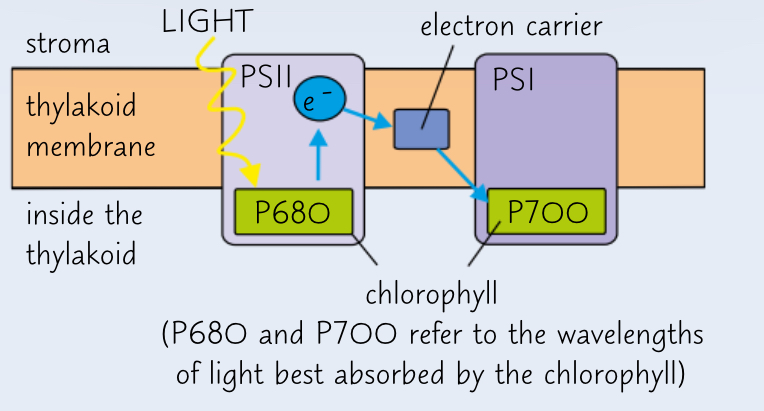
Describe how Photolysis of water produces protons(H+), electrons, O2 and what are they used for
Water is split into H+, O2 and e-
H+ is picked up by NADP to form reduced NADP.
e- passed along chain of electron carrier proteins
O2 is used for respiration or diffuses out of leaf through stomata.
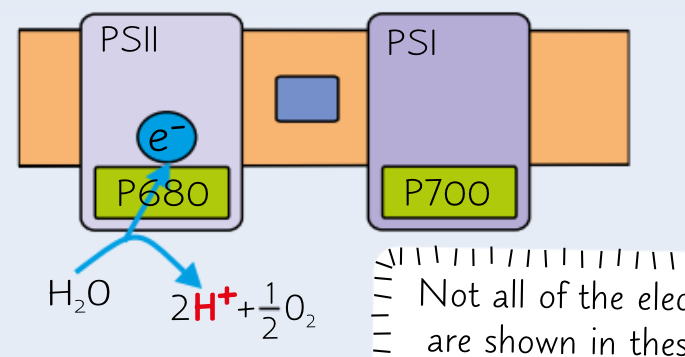
Explain the Light Dependant Reaction
Electrons that gained energy and left the chlorophyll move along a series of proteins embedded which in the thylakoid membrane.
As they move, they release energy and some is used to pump proteins across chloroplast membranes.
An electrochemical gradient is created. The protons pass through ATP synthase, resulting in the production of ATP.
The protons combine with co-enzyme NADP to form reduced NADP.
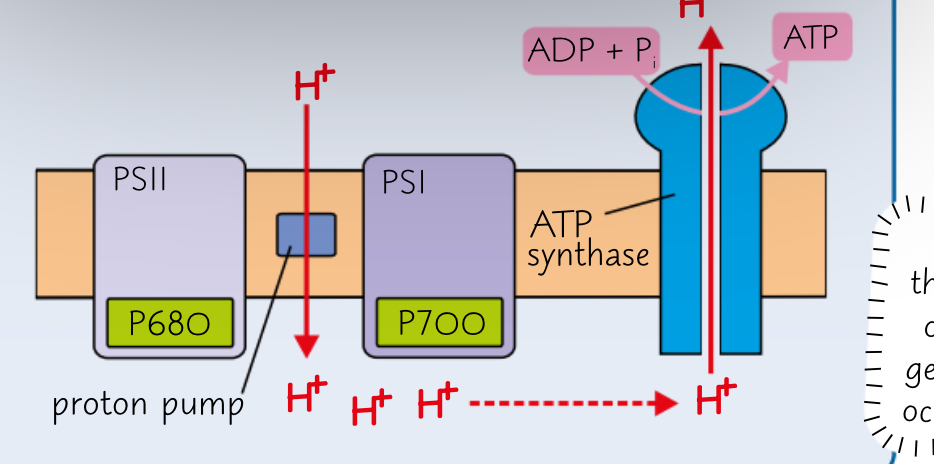
Describe how the energy from the excited electrons forms reduced NADP(non-cyclic Photophosphorylation)
Light energy is absorbed by PSI, which excites the electrons again to an even higher energy level.
The electrons are transferred to NADP, along with a proton from the stroma, to form reduced NADP.
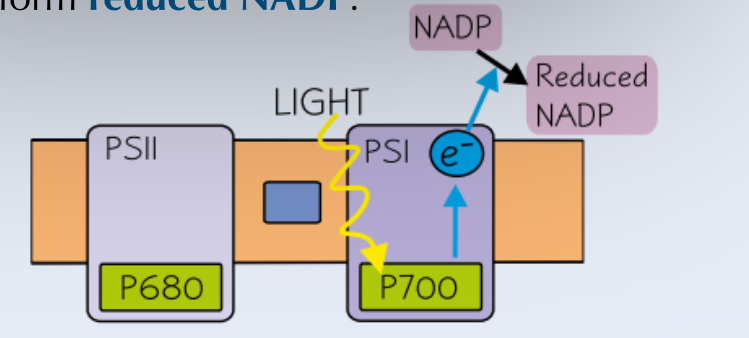
Describe how cyclic Photophosphorylation only produces ATP
Only uses PSI.
The electrons from the chlorophyll molecule aren’t passed onto NADP, but are passed back to PSI via electron carriers.
Meaning the electrons are recycled and can repeatedly flow through PSI.
Doesn’t produce any reduced NADP or O2.

Describe the Calvin Cycle (also known as the Light independent reaction)
CO2 reacts with RuBP to form 2 molecules of GP(3C). This reaction is catalysed by RUBISCO.
GP is reduced to GALP using energy from ATP and by accepting a H from reduced NADP.
Some of the carbon from GALP leaves the cycle each turn to be converted into useful substances.
The rest of the molecule is used to regenerate RUBP, with energy from ATP.
The calcium cycle must repeat 6 times to form a hexose sugar. Eg. Glucose.
Describe how carbon dioxide is combined with ribulose biphosphate to form two molecules of glycerate 3-phosphate in the Calvin Cycle
CO2 enters the leaf through the stomata and diffuses into the stroma of the chloroplast.
It’s combined with RuBP. Catalysed by RUBISCO.
Giving an unstable 6-carbon compound, which quickly breaks down into two molecules of a 3-carbon compound call glycerate 3-phosphate(GP).
Describe how ATP and reduced NADP are required for the reduction of GP to glyceraldehyde 3-phosphate in the Calvin cycle
Hydrolysis of ATP provides energy to turn 3-carbon compound, GP, into a different 3-carbon compound called GALP.
The reaction also required H+ ions from reduced NADP. Reduced NADP is recycled to NADP.
Some GALP is converted into useful organic compounds(eg.glucose) and some continues in the Calvin cycle to regenerate RuBP.
Describe how Ribulose biphosphate is regenerated in the Calvin Cycle
Two molecule of GALP can be used to make a hexose sugar.(eg.glucose).
However, 5 of every 6 molecules of GALP produced in the cycle aren’t used to make hexose sugars, but to regenerate RuBP.
Regenerating RuBP uses the rest of the ATP produced by the light-dependant reaction.
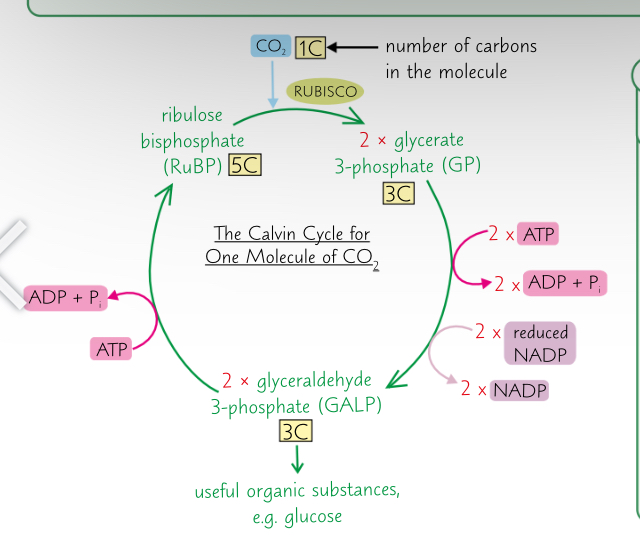
Explain how the products made from the Calvin Cycle can be used to make other organic substances
Carbohydrates- simple sugars are made by joining two GALP molecules, polysaccharides are made by joining hexose sugars in different ways. Glucose is used for respiration, which provides energy.
Lipids- made using glycerol, which is synthesised by GALP, and fatty acids which are synthesised by GP.
Amino Acids- some are made from GP.
Nucleic Acids- ribose is made from GALP.
How is energy transferred through ecosystems?
Energy enters via photosynthesis-producers.
energy is transferred when organisms eat each other.
Each stage is a trophic level.
Why might some energy not be transferred to the next trophic level?
Some light isnt the right wavelength, so the energy cant be used.
Some sunlight isnt used when it hits a part of a plant that cant photosynthesise.
Some parts of the organism isnt eaten-bones.
Some parts of food are indigestible-so come out as waste.
Energy lost through respiration.
Define Net Productivity
The chemical energy stored in plant biomass after respiratory losses to the environment have been taken into account.
Define Gross Productivity
The chemical energy stored in plant biomass.
What is the equation for Net Productivity?
Gross Productivity- Respiratory Loss
What is the equation to calculate Net Primary Productivity?
Gross Primary Productivity - Plant Respiration
How are Temperature Records evidence for Climate Change?
Since 1850s temperature has been recorded with thermometers.
Reliable short-term record of global temperature change.
How is Dendrochronology(Tree Rings) evidence for Climate Change?
Shows how old a tree is, one ring per year.
Thickness of the rings depends on the climate- warmer=thicker ring.
Scientists take cores through tree trunks and date each ring by counting back from when the core was taken. They look at the thickness to determine the climate at that time.
How is Pollen in Peat Bogs evidence for Climate Change?
Shows how temperature has changed over time.
Pollen is preserved in Peat Bogs.
Peat Bogs accumulate in layers, so the age of the preserved pollen increases with depth.
Only mature plants produce pollen, so the samples show the species that were successful at the time.
So, an increase in pollen from a plant species that’s more successful in warmer climates would show a rise in tempurature.
Describe CO2 and where it comes from.
The concentration of CO2 is increasing as more fossil fuels, like coal and oil are burnt.
CO2 is also increased by the destruction of natural sinks, like trees.
They store CO2 as organic compounds and its released when its burnt or when decomposes break down the organic compounds and respire them.
Describe Methane and where it comes from.
Methane concentration is increasing because more fossil fuels are being extracted, there’s more decaying waste and there are more cattle release methane as a waste gas.
Methane can be released from natural stores, like permafrost due to increasing temperatures.
What Human Activities increase the concentration of fossil fuels?
Burning Fossil Fuels.
Farming.
Deforestation.
What limitations do Model of Future Climate Change based on extrapolated data have?
Don’t know how greenhouse gas emissions will change.
Don’t known exactly how much each emissions scenario will cause the global temperature to rise by.
Don’t know what attempts to manage the atmospheric concentration of greenhouse gases there will be, or how successful they’ll be.
Don’t know what effect increasing greenhouse gas concentrations will actually have on the climate.
How does global warming affect the rate of enzyme activity?
When the temperature increases the rate of enzyme controlled activities increases.
But when the temperature gets too high:
Enzyme molecules vibrate more.
When the temperature goes above a certain level, the vibration breaks some of the bonds that hold the enzyme in shape.
Active site changes shape and the enzyme and substrate don’t fit together.
The enzyme has denatured and can no longer act as a catalyst.
How does the changing rate of enzyme activity affect organisms life cycles, development and distribution?
Metabolism is all the chemical reactions that take place in its cells in order to keep it alive, metabolic actions are controlled by enzymes.
So, an increase in the rate of metabolic activities speeds up the rate of growth. The organisms progress through their life cycle faster.
But if the tempurature is too high, metabolic rates will slow and their rate of growth will too. Meaning they’ll progress through their life cycle slower.
Global warming affects distribution as organisms exist where conditions are ideal for their survival, but if they change they have to move to a new area where the conditions are better. If they can’t move they’ll die out in that area.
The range of some species may expand if the conditions in previously uninhabitable areas change.
How does Changing Rainfall patterns affect plants and animals?
Affects development and life cycles of some organisms.
Affects distributions of some species. For example, deserts could increase in area if there is a decrease in rainfall.
Species that aren’t adapted to live in deserts will have to move to new areas or they’ll dry out.
Describe how Seasonal Changes affects plants ad animals?
Global warming changes the time of seasons.
Organisms are adapted to the timing of seasons and the changes that happen.
Changing seasonal cycles will affect the development and life cycles of some organisms.eg. Red Squirrels in Canada give birth earlier because there’s more food.
Affects the distribution of species, eg. Swallows moving to Europe to breed may get there when there’s no food available, because spring come around earlier than normal.
Why might people disagree about whether humans are causing Climate change?
They think the increase in atmospheric CO2 concentration isn’t the main cause of increase of global temperatures.
Describe the Carbon Cycle
Carbon is absorbed by plants during photosynthesis.
Carbon is passed onto animals when they eat the plants and to decomposes when they eat the dead organic matter.
Carbon is returned to the atmosphere during respiration.
If dead organic matter ends up in places where there aren’t any decomposers, carbon compounds can be turned into fossils.
Carbon in fossil fuels is released as CO2-combustion.
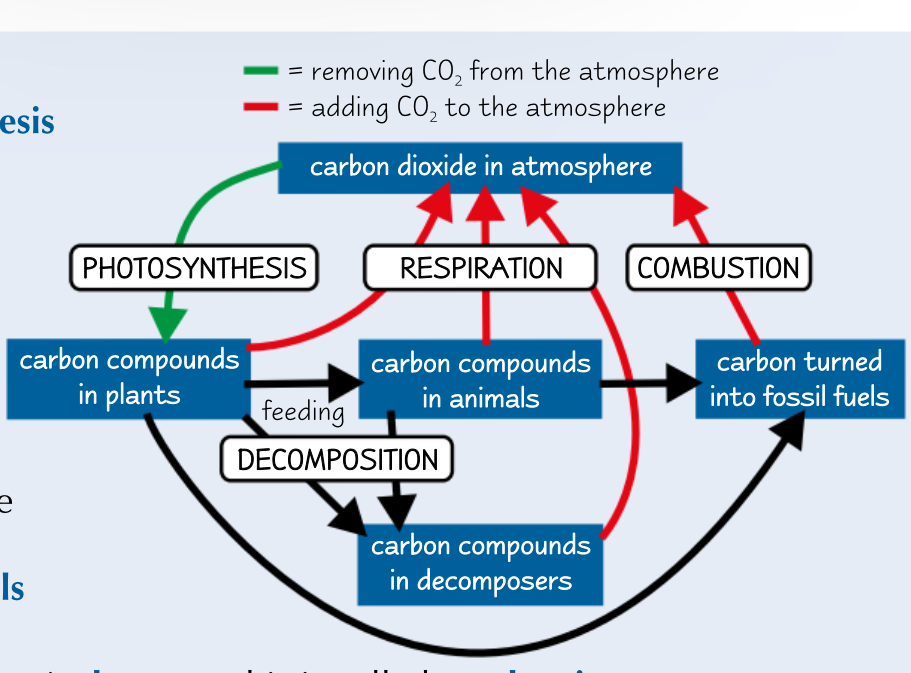
Describe how Biofuels decrease the atmospheric CO2 concentration
Biofuels are produced from biomass-eg.crops which can be replanted which is sustainable.
They’re burnt and release CO2.
There’s no net increase in atmospheric CO2 concentration when biofuels are burnt.
Using biofuels stops the increase of atmospheric CO2.
Describe how Reforestation decreases the atmospheric CO2 concentration
Reforestation is the planting of new trees in existing forests that have been depleted.
More trees mean more CO2 is removed from the atmosphere by photosynthesis.
CO2 is converted into carbon compounds and stored as plant tissues in the trees. This means more carbon is kept out of the atmosphere, so there’s less CO2 contributing to global warming.
Describe why some people my oppose or support increasing the use of biofuels to reduce Climate Change
Some farmers might support this-some governments fund the farming of crops for biofuels.
Drivers might support this-the price of biofuels is usually lower than oil based fuels.
Consumers might oppose this strategy-using farmland to grow crops for biofuels could cause food shortages.
Conservationists might oppose this strategy-forests have been cleared to grow crops for biofuels.
Describe why some people might oppose or support increasing the use of wind turbines to reduce Climate Change
Companies that make wind turbines would support this-their sales would increase.
Environmentalists might support this-wind turbines produce electricity without increasing atmospheric CO2 concentration.
Local communities might oppose this-some people think wind turbines ruin the landscape.
Bird conservationists might oppose this-many birds are killed by flying into wind turbines.
Define evolution
When the frequency of an allele in a population changes over time. It occurs by natural selection.
Describe how evolution occurs
Individuals within a population vary due to different alleles. Different alleles are due to gene mutations.
So, some individuals are better adapted to their environment than others.
Individuals that have an allele that increases their chance of survival are more likely to survive, reproduce and pass on their genes than individuals with different alleles.
Meaning a greater proportion of the next generation inherit the beneficial allele.
They are more likely to survive, reproduce and pass on their genes. So, the frequency of the beneficial allele increases from generation to generation.
Describe how Isolation reduces Gene Flow
Speciation happens when populations of the same specie as become reproductively isolated, reducing gene flow between two populations.
Meaning natural selection acts on each population separately - so new species can develop.
Reproductive isolation may occur because of geographical isolation (allopatric speciation) or because random mutations produce changes in phenotype that prevent populations from mating (sympathetic speciation).
Describe Allopatric Speciation (Requires geographical isolation)
Populations that are geographically separated will experience slightly different conditions.
The populations experience different selection pressures and so different changes in allele frequencies could occur.
Different alleles will be more advantageous in different populations.
Allele frequencies will also change as mutations occur independently in each population.
How may seasonal changes cause reproductive isolation?
Individuals of the same population develop different mating or flowering seasons, or become sexually active at different times of the year.
How might Mechanical Changes cause Reproductive Isolation?
Changes in genitalia prevent successful mating.
How might Behavioural Changes cause Reproductive Isolation?
A group of individuals develop courtship rituals that aren’t attractive to the main populations.
What does Sympatric Isolation not need to occur?
Geographical Isolation.
How does Sympatric Speciation Occur?
Random mutations occur, leading to reproductive isolation preventing members of that population breeding with other members of the species.
How does Genomics support the theory of evolution?
Evolution suggests all organisms evolved from a shared common ancestors.
Closely related species diverged more recently.
Evolution is caused by the gradual change in the base sequence of organisms DNA.
Organisms that diverged more recently have more similar DNA.
How to Proteomics support the theory of evolution?
The study of proteins.
The sequence of amino acids in a protein is coded for by the DNA sequence in a gene.
Related organisms have similar DNA sequences and so similar amino acid sequences in their proteins.
Organisms that diverged more recently have more similar proteins.
Describe how Scientific Journals are used to validate evidence
They allow scientists to repeat experiments and see if they get the same results using the same method.
If the results can be replicated, the evidence collected is reliable.
Describe how Peer Review if used to validate evidence
Occurs before work if published in a journal.
This is when other scientists who work in that area read and review the work.
Peer reviewer check that the work is valid and that it supports the conclusions.
This makes sure evidence published is valid and that experiments are carried out to the highest standard.
Describe how Conferences are used to validate evidence
Meetings where they can discuss each others work.
Scientists with important or interesting results present their work in the form of a lecture.
Other scientists ask questions and discuss their work with them face to face.
Conferences are an easy way for the latest theories and evidence to be shared and discussed.